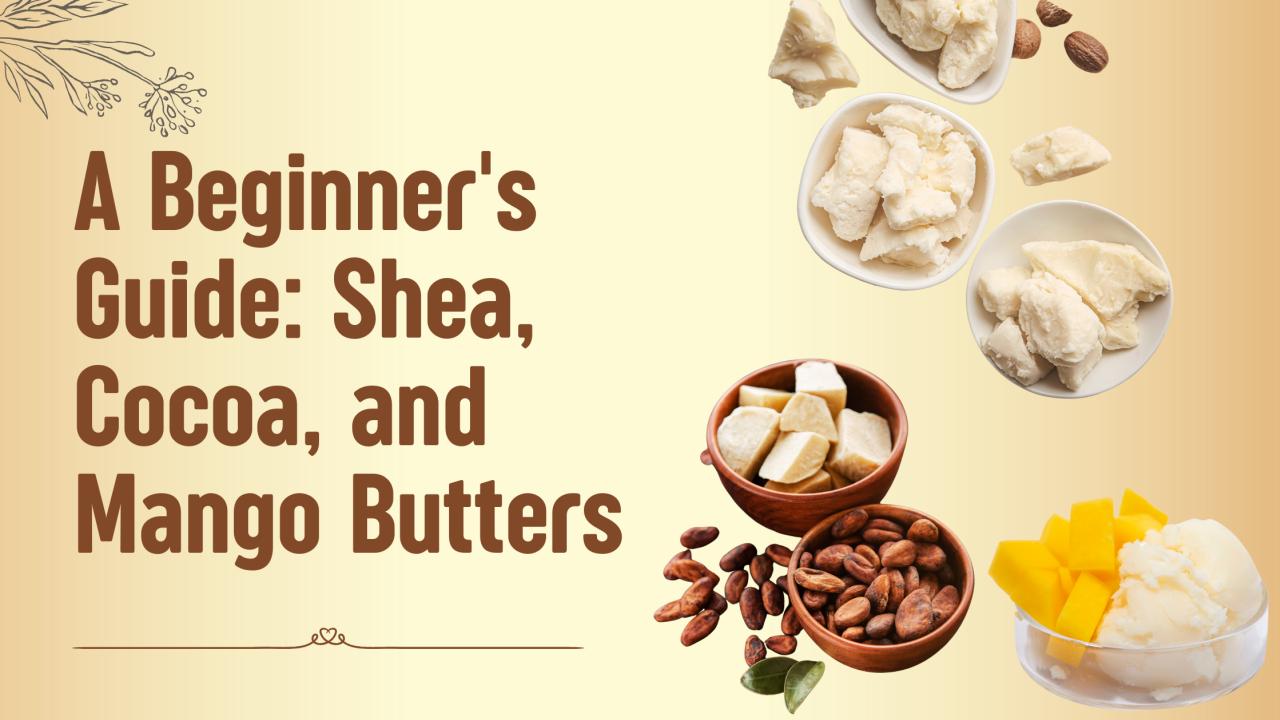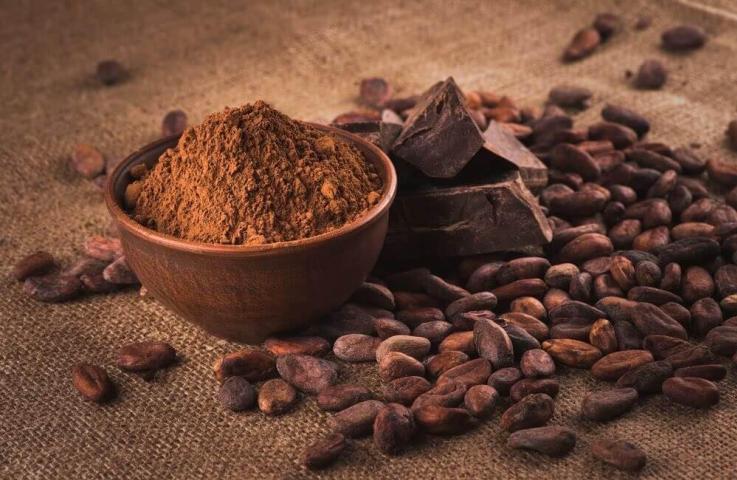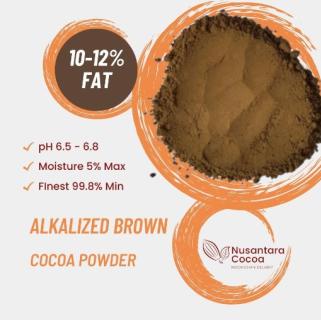In the world of skincare, natural
ingredients reign supreme, and few products embody this essence better than
butters. Shea
butter, cocoa
butter, and mango butter
have captured the hearts of beauty enthusiasts and DIY creators alike. These
creamy treasures not only nourish the skin but also offer a luxurious
experience that synthetic alternatives often fail to match. Embracing these
butters means embracing nature's best-kept secrets for radiant skin and hair.
Shea butter is renowned for its
deep hydration and healing properties, making it a staple in many beauty
routines. Cocoa butter, with its rich texture and delightful aroma, is
celebrated for enhancing skin elasticity and providing a soothing barrier against
dryness. Meanwhile, mango butter stands out with its lightweight feel and
unique ability to calm sensitive skin. Each of these natural butters brings its
own magical touch to skincare, promising a blend of nourishment and indulgence
that transforms your beauty regimen.
Ready to delve deeper into the
world of shea, cocoa, and mango butters? Join us as we explore their origins,
benefits, and practical tips for incorporating these wonders into your everyday
routine. Your journey to discovering the magic of natural butters starts here!
Understanding Shea Butter
Shea butter,
a luxurious and nourishing ingredient, hails from the nuts of the shea tree
(Vitellaria paradoxa), which is native to West Africa. The traditional
extraction process involves harvesting the nuts, drying them in the sun, and
then crushing them to release the oil. This oil is then boiled and whipped into
a creamy consistency that forms the rich shea butter we know today. This
time-honored method not only preserves the integrity of the butter but also
connects consumers to the communities that rely on this resource for their
livelihoods.
The skin benefits of shea butter
are numerous and well-documented. It is renowned for its deep moisturizing
properties, making it an excellent choice for dry or flaky skin. Packed with
vitamins A and E, shea butter promotes skin cell regeneration and helps to
soothe irritated skin, making it a popular remedy for conditions like eczema
and psoriasis. Additionally, its anti-inflammatory properties can reduce
redness and swelling, while the fatty acids in shea butter provide a protective
barrier against environmental stressors. Beyond its skin benefits, shea butter
is also a boon for hair. It nourishes the scalp and can help alleviate dryness
and flakiness, while also providing moisture to brittle strands, resulting in
softer, more manageable hair.
Incorporating shea butter into
your beauty routine is simple and rewarding. For a quick fix, consider using it
as a body moisturizer after your shower; just warm a small amount between your
palms and massage it into your skin. You can also blend shea butter with
essential oils to create a personalized scent or add it to your favorite lotion
for an extra hydration boost. If you're feeling adventurous, try using it as a
hair mask—apply it to your dry ends and leave it on for 30 minutes before
washing it out for silky, rejuvenated hair. Whether used alone or mixed with
other natural ingredients, shea butter can elevate your skincare and haircare
rituals to new heights.
The Magic of Cocoa Butter
Cocoa butter,
derived from the beans of the cacao tree, has a rich history that dates back to
ancient civilizations. The Mayans and Aztecs revered cocoa not only as a food
source but also for its soothing properties, often using it in various rituals
and beauty practices. This luxurious butter gained popularity over the
centuries, particularly during the 19th century when it became a key ingredient
in chocolate production. Today, cocoa butter stands out in the beauty world as
a powerful natural moisturizer that hydrates and rejuvenates the skin.
One of the standout benefits of
cocoa butter is its ability to improve skin hydration and elasticity. Packed
with fatty acids and antioxidants, it forms a protective barrier on the skin,
locking in moisture and promoting a supple appearance. This makes it an
excellent choice for those looking to combat dryness or maintain youthful skin.
Additionally, cocoa butter's emollient properties can help reduce the
visibility of scars and stretch marks, making it a popular ingredient in
various beauty formulations designed for those specific concerns.
For DIY enthusiasts,
incorporating cocoa butter into your beauty routine is both simple and
rewarding. To create a rich body lotion, melt cocoa butter together with other
oils like coconut or almond oil, then allow it to cool before whisking it until
creamy. This blend not only nourishes your skin but also leaves behind a
delightful chocolatey scent that elevates your self-care ritual. If you're
feeling adventurous, you can also mix cocoa butter into lip balms or hair
treatments to harness its hydrating qualities in multiple ways.
In summary, cocoa butter is more
than just a decadent ingredient; it's a versatile ally in your quest for
healthy, radiant skin. Its historical significance combined with impressive
skin benefits and ease of use in DIY formulations makes it a must-have for
anyone passionate about natural skincare. Whether you're a seasoned beauty
creator or just starting out, cocoa butter offers endless possibilities to
enhance your beauty regimen while embracing the magic of nature.
Exploring Mango Butter
Mango butter,
derived from the seeds of the mango fruit, stands out in the world of natural
butters due to its unique composition and nourishing qualities. Unlike other
butters, mango butter is lightweight and easily absorbed by the skin, making it
an excellent option for those looking for hydration without a heavy or greasy
feel. Its creamy texture and subtle, tropical scent evoke a sense of
indulgence, making it a favorite among DIY skincare enthusiasts and cosmetic
formulators alike. As a versatile ingredient, mango butter can be used in a
range of products, from lotions and balms to hair treatments and lip care.
One of the most remarkable
benefits of mango butter is its ability to soothe sensitive skin. Rich in
vitamins A and C, as well as essential fatty acids, this natural butter helps
to calm irritation and reduce redness, making it ideal for individuals with
conditions like eczema or dermatitis. Its anti-inflammatory properties provide
relief while also promoting skin regeneration and elasticity. For those with
delicate skin, incorporating mango butter into your routine can offer a gentle
yet effective solution for hydration and nourishment, often leaving the skin
feeling soft and revitalized.
There are numerous ways to use
mango butter in your skincare regimen. It can be applied directly as a
moisturizer or blended with other natural ingredients in DIY formulations. For
instance, you can create a soothing body balm by mixing mango butter with shea
butter and a few drops of essential oils like lavender or chamomile. This
combination not only enhances the soothing properties but also provides a
delightful aroma. Additionally, mango butter can be added to homemade scrubs or
masks to deliver an extra boost of moisture. Its adaptability allows you to
tailor your skincare products to meet your specific needs while enjoying the
benefits of this luxurious ingredient.
In summary, mango butter is not
just a lovely addition to your beauty cabinet; it’s a powerhouse of nourishment
that can transform your skincare routine. Whether you're dealing with sensitive
skin or simply seeking a lightweight moisturizer, this unique butter has
something to offer everyone. Embrace the magic of mango butter and discover how
it can elevate your DIY skincare creations and enhance your overall beauty
regimen.
Comparing the Three Butters
When it comes to natural butters,
each has its unique nutritional profile and fatty acid composition that cater
to different skin needs. Shea butter is rich in oleic acid and stearic acid,
making it incredibly moisturizing and ideal for dry skin. Cocoa butter, on the
other hand, is packed with saturated fats that enhance its ability to improve
skin elasticity while providing a protective barrier against environmental
stressors. Mango butter stands out with its high content of palmitic acid,
which offers excellent emollient properties, making it a perfect choice for
sensitive skin types seeking soothing hydration.
The specific benefits of each
butter can address a variety of skin concerns. For instance, shea butter’s
anti-inflammatory benefits make it an excellent choice for individuals with
conditions such as eczema or psoriasis. Its rich texture not only hydrates but
also calms irritated skin. Cocoa butter is particularly beneficial for those
looking to improve the appearance of stretch marks due to its ability to
enhance skin elasticity. Meanwhile, mango butter’s light consistency makes it
suitable for sensitive areas like the face or around the eyes, where gentle
care is paramount.
Choosing the right butter for
your beauty needs often depends on your skin type and concerns. If you have
extremely dry or cracked skin, shea butter could be your best ally due to its
deep moisturizing properties. For those dealing with uneven skin texture or
stretch marks, incorporating cocoa butter into your routine may provide the
best results. Conversely, if you’re looking for a lightweight option that still
offers hydration without clogging pores, mango butter might just be the perfect
fit. Understanding these differences allows you to tailor your skincare regimen
to your unique needs while harnessing the natural benefits each butter
provides.
DIY Beauty Recipes with Natural Butters
Creating your own beauty products
at home can be a rewarding experience, especially when using the luxurious
benefits of natural butters like shea, cocoa, and mango. For a simple yet
effective body scrub, combine 1 cup of sugar with ½ cup of melted shea butter
and a few drops of your favorite essential oil. This exfoliating blend will not
only remove dead skin cells but also deeply moisturize your skin, leaving it
soft and radiant. For an added twist, consider incorporating coffee grounds for
an invigorating scent and extra exfoliation—perfect for those early mornings!
If you’re looking to nourish your
hair, a DIY hair treatment using cocoa butter can work wonders. Melt ¼ cup of
cocoa butter and mix it with ¼ cup of coconut oil and a tablespoon of honey.
Apply this rich mixture to your hair, focusing on the ends, and leave it in for
about 30 minutes before rinsing. The result? Shiny, hydrated locks that feel
revitalized. This treatment is particularly beneficial for dry or damaged hair,
as both cocoa butter and coconut oil are known for their moisturizing
properties.
When experimenting with DIY
formulations, safety is paramount. Always conduct a patch test before applying
any new product to your skin or hair to avoid allergic reactions. Additionally,
ensure that all utensils and containers used in your DIY process are clean to
prevent contamination. It’s also wise to store your creations in cool, dark
places to extend their shelf life, especially since natural butters can melt in
warm temperatures. By following these best practices, you can enjoy the
beautiful benefits of shea, cocoa, and mango butters without worry, embracing a
more natural approach to your beauty routine.
The Role of Natural Butters in Sustainable Beauty
In recent years, the beauty
industry has witnessed a significant shift towards sustainability, and natural
butters like shea, cocoa, and mango play a pivotal role in this movement.
Sourced from the nuts and seeds of various trees, these butters are often
harvested through traditional methods that prioritize ecological balance and
community welfare. For instance, shea butter is typically collected by local
women in West Africa, who have cultivated the shea tree for generations. By
supporting this process, consumers not only gain access to high-quality
skincare ingredients but also contribute to the preservation of traditional
practices and local biodiversity.
The impact of choosing natural
butters extends beyond personal beauty routines; it resonates deeply within
local communities and economies. Many of these communities depend on the
sustainable harvesting of shea, cocoa, and mango for their livelihoods. Fair
trade initiatives ensure that producers receive fair compensation for their
labor, empowering them economically and socially. This financial stability
allows them to invest in education, healthcare, and better living conditions.
By purchasing products made with ethically sourced natural butters, consumers
help create a cycle of positive change that uplifts entire communities.
Moreover, opting for natural butters over synthetic alternatives supports a healthier planet. The production of synthetic ingredients often involves harmful chemicals and processes that can damage ecosystems and contribute to pollution. In contrast, natural butters are biodegradable and derived from renewable resources, making them a more environmentally friendly choice. By selecting products that feature these natural ingredients, beauty enthusiasts can actively participate in reducing their carbon footprint and promoting a more sustainable life>
In conclusion, embracing shea,
cocoa, and mango butters not only enhances your skincare routine but also
fosters a broader commitment to sustainability. By prioritizing eco-friendly
sourcing practices and supporting local economies, you are contributing to a
healthier planet while indulging in the nourishing benefits these magical
butters offer. It's a win-win situation that aligns beauty with responsibility,
making every application a step toward positive global change.
Common Myths about Natural Butters
Despite the rising popularity of
shea, cocoa, and mango butters in the beauty industry, several misconceptions
still linger. One of the most prevalent myths is that these natural butters are
overly greasy and unsuitable for oily skin types. In reality, shea butter, for
instance, is a non-comedogenic ingredient, meaning it won’t clog pores. Its
unique composition allows it to hydrate the skin without leaving a heavy
residue, making it suitable for various skin types, including oily and
combination skin. By understanding this, consumers can feel more confident
incorporating shea butter into their routines.
Another common concern revolves
around allergies. Many people believe that because these butters are derived
from nuts and fruits, they may pose a risk for those with allergies. While it's
true that individuals with nut allergies should exercise caution with shea
butter (derived from the nuts of the shea tree), both cocoa and mango butters
are generally safe for most skin types. It's essential to conduct a patch test
before widespread application, as everyone's skin reacts differently.
Additionally, many brands are now transparent about their ingredient sourcing
and allergen information, empowering consumers to make informed choices.
Ingredient transparency is
another critical topic in the conversation about natural butters. Some
consumers worry that products labeled as containing "natural butters"
might also include synthetic additives or fillers that dilute their benefits.
This concern underscores the importance of reading labels carefully and seeking
out brands that prioritize clean formulations. By choosing products that
highlight pure shea, cocoa, or mango butter as key ingredients, beauty
enthusiasts can avoid unnecessary chemicals and fully experience the nurturing
qualities these butters have to offer.
In summary, by debunking these
myths surrounding shea, cocoa, and mango butters, we can foster a deeper
understanding of their benefits and suitability for a wide range of skin types.
As awareness grows, consumers can embrace these natural treasures with
confidence, enriching their skincare routines while enjoying the profound
advantages of nature's bounty.
Embrace the Power of Natural Butters
In conclusion, shea, cocoa, and
mango butters each bring unique benefits to your skincare routine. Shea butter
is renowned for its deep hydration and nourishing properties, making it a
favorite for both skin and hair. Cocoa butter offers superior elasticity and
hydration, while mango butter soothes sensitive skin and adds a luxurious touch
to any product. Together, these natural butters can transform your beauty
regimen into a holistic experience.
We encourage you to explore the
wonders of these butters in your daily routines. Whether you’re a DIY
enthusiast or simply seeking healthier options, incorporating natural
ingredients can elevate your skincare game. Embracing shea, cocoa, and mango
butters not only enhances your beauty but also supports a more sustainable and
eco-friendly approach to self-care. Dive into the magic of these natural
treasures and let them work their wonders on your skin!








